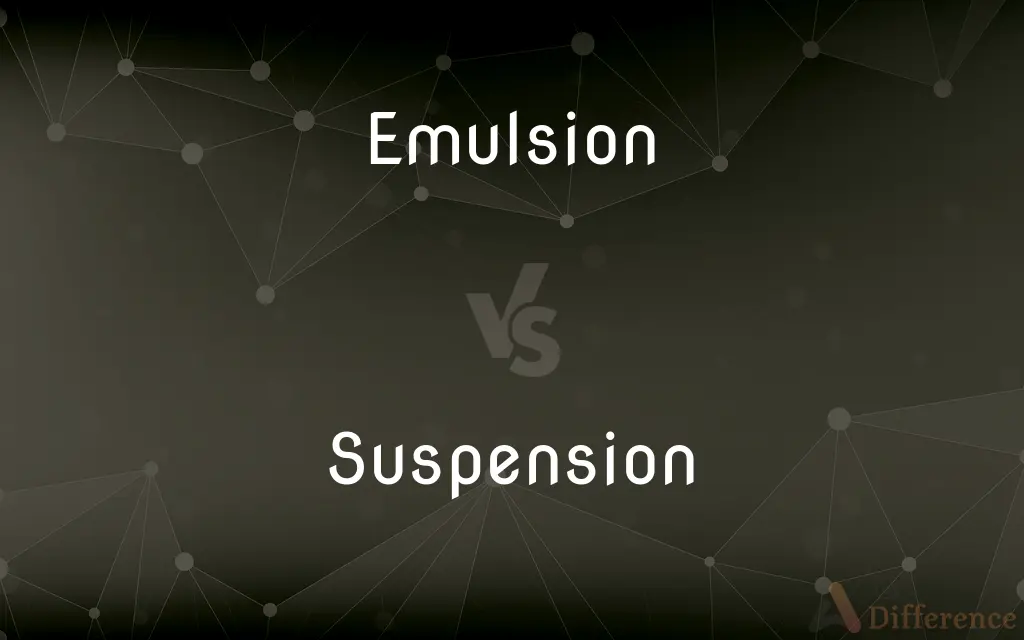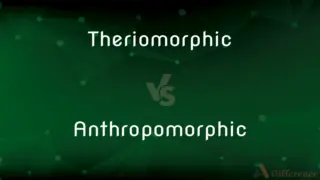Emulsion vs. Suspension — What's the Difference?
Edited by Tayyaba Rehman — By Maham Liaqat — Updated on March 25, 2024
An emulsion is a mixture of two liquids that don't normally mix, stabilized by an emulsifying agent, while a suspension involves solid particles dispersed in a liquid.

Difference Between Emulsion and Suspension
Table of Contents
ADVERTISEMENT
Key Differences
Emulsions are mixtures where tiny droplets of one liquid are dispersed evenly throughout another, thanks to the presence of emulsifiers which prevent the liquids from separating. Common examples include mayonnaise and milk. Suspensions, on the other hand, consist of solid particles that are dispersed within a liquid but, unlike emulsions, these particles will eventually settle over time due to gravity, as seen in sand mixed with water.
The stability of emulsions is achieved through emulsifying agents, substances that have both hydrophilic and hydrophobic ends, making them capable of binding water and oil together. Suspensions lack such agents, resulting in the eventual separation of the dispersed particles from the liquid, requiring agitation to redisperse evenly.
Emulsions can be classified into oil-in-water (O/W) or water-in-oil (W/O), depending on the phase dispersion, which affects their properties and applications. Suspensions do not have such classifications since they involve solid particles in a liquid and their characteristics depend on factors like particle size and density rather than the dispersion medium.
The appearance of emulsions is typically cloudy or milky due to the light scattering by the dispersed droplets, making them opaque. Suspensions may also appear cloudy when shaken but will become clear once the particles settle.
In terms of applications, emulsions are widely used in the food industry, cosmetics, and pharmaceuticals, where the stabilization of incompatible ingredients is necessary. Suspensions find their applications in pharmaceuticals, paints, and wastewater treatment, where the settling of particles can be utilized or needs to be managed.
ADVERTISEMENT
Comparison Chart
Components
Two immiscible liquids
Solid particles in a liquid
Stability
Stabilized by emulsifying agents
Particles settle over time, not stable
Classification
Oil-in-water (O/W) or water-in-oil (W/O)
Based on particle size and density
Appearance
Cloudy or milky, opaque
Cloudy initially, clears upon settling
Applications
Food, cosmetics, pharmaceuticals
Pharmaceuticals, paints, wastewater treatment
Compare with Definitions
Emulsion
Can be oil-in-water or water-in-oil.
Butter is a water-in-oil emulsion.
Suspension
Particles will settle over time.
Orange juice with pulp needs shaking before drinking.
Emulsion
Emulsions are mixtures of two immiscible liquids.
Salad dressings often contain oil and vinegar emulsified together.
Suspension
Suspensions contain solid particles in a liquid.
Sand in water forms a simple suspension.
Emulsion
Stabilized by emulsifiers.
Lecithin in mayonnaise keeps oil and water mixed.
Suspension
Appearance clears upon settling.
Muddy water becomes clear as the dirt settles.
Emulsion
Appear cloudy or milky.
Milk's creaminess is due to its emulsion nature.
Suspension
Applied in paints and pharmaceuticals.
Some liquid medicines are suspensions that require shaking.
Emulsion
Used in foods and cosmetics.
Lotions are emulsions that moisturize the skin.
Suspension
Lack emulsifying agents.
Suspended chalk particles in water will eventually settle.
Emulsion
An emulsion is a mixture of two or more liquids that are normally immiscible (unmixable or unblendable) owing to liquid-liquid phase separation. Emulsions are part of a more general class of two-phase systems of matter called colloids.
Suspension
An interruption or temporary cessation, as of an activity or of the application of a rule or law.
Emulsion
A fine dispersion of minute droplets of one liquid in another in which it is not soluble or miscible
Oil beaten to an emulsion with a half tablespoonful of vinegar
Suspension
A temporary prohibition or exclusion, as from attending school or enjoying a privilege, especially as a punishment.
Emulsion
A type of paint used for walls, consisting of pigment bound in a synthetic resin which forms an emulsion with water
Three coats of white emulsion
Suspension
A postponement, as of a judgment, opinion, or decision.
Emulsion
Paint with emulsion
If the lining paper is not opaque, the wall should also be emulsioned
Suspension
The prolongation of one or more tones of a chord into a following chord to create a temporary dissonance.
Emulsion
A suspension of small globules of one liquid in a second liquid with which the first will not mix
An emulsion of oil in vinegar.
Suspension
The tone or tones so prolonged.
Emulsion
A photosensitive coating, usually of silver halide grains in a thin gelatin layer, on photographic film, paper, or glass.
Suspension
A device from which a mechanical part is suspended.
Emulsion
A stable suspension of small droplets of one liquid in another with which it is immiscible.
Mayonnaise is an emulsion where egg is used to keep oil and water mixed.
Suspension
The system of springs and other devices that insulates the chassis of a vehicle from shocks transmitted through the wheels.
Emulsion
(chemistry) A colloid in which both phases are liquid.
Suspension
(Chemistry) A system in which minute particles are dispersed throughout a fluid from which they are easily filtered but not easily settled because of system viscosity or molecular interactions.
Emulsion
(photography) The coating of photosensitive silver halide grains in a thin gelatine layer on a photographic film.
Suspension
The act of suspending, or the state of being suspended.
Suspension from a hook
Emulsion
Any liquid preparation of a color and consistency resembling milk; as: (a) In pharmacy, an extract of seeds, or a mixture of oil and water united by a mucilaginous substance. (b) In photography, a liquid preparation of collodion holding salt of silver, used in the photographic process.
Suspension
A temporary or conditional delay, interruption or discontinuation.
Emulsion
(chemistry) a colloid in which both phases are liquids;
An oil-in-water emulsion
Suspension
The state of a solid or substance produced when its particles are mixed with, but not dissolved in, a fluid, and are capable of separation by straining.
Emulsion
A light-sensitive coating on paper or film; consists of fine grains of silver bromide suspended in a gelatin
Suspension
Thus a kind of silt or sludge.
Suspension
The act of keeping a person who is listening in doubt and expectation of what is to follow.
Suspension
The temporary barring of a person from a workplace, society, etc. pending investigation into alleged misconduct.
Suspension
(education) The process of barring a student from school grounds as a form of punishment (particularly out-of-school suspension).
Suspension from school as a disciplinary measure
Suspension
(music) The act of or discord produced by prolonging one or more tones of a chord into the chord which follows, thus producing a momentary discord, suspending the concord which the ear expects.
Suspension
A stay or postponement of the execution of a sentence, usually by letters of suspension granted on application to the Lord Ordinary.
Suspension
(topology) A topological space derived from another by taking the product of the original space with an interval and collapsing each end of the product to a point.
Suspension
(topology) A function derived, in a standard way, from another, such that the instant function’s domain and codomain are suspensions of the original function’s.
Suspension
(vehicle) The system of springs and shock absorbers connected to the wheels in an automobile, which allows the vehicle to move smoothly with reduced shock to its occupants.
Suspension
The act of suspending, or the state of being suspended; pendency; as, suspension from a hook.
Suspension
Especially, temporary delay, interruption, or cessation
Suspension
A conditional withholding, interruption, or delay; as, the suspension of a payment on the performance of a condition.
Suspension
The state of a solid when its particles are mixed with, but undissolved in, a fluid, and are capable of separation by straining; also, any substance in this state.
Suspension
A keeping of the hearer in doubt and in attentive expectation of what is to follow, or of what is to be the inference or conclusion from the arguments or observations employed.
Suspension
A stay or postponement of execution of a sentence condemnatory by means of letters of suspension granted on application to the lord ordinary.
Suspension
The prolongation of one or more tones of a chord into the chord which follows, thus producing a momentary discord, suspending the concord which the ear expects. Cf. Retardation.
Suspension
A mixture in which fine particles are suspended in a fluid where they are supported by buoyancy
Suspension
A time interval during which there is a temporary cessation of something
Suspension
Temporary cessation or suspension
Suspension
An interruption in the intensity or amount of something
Suspension
A mechanical system of springs or shock absorbers connecting the wheels and axles to the chassis of a wheeled vehicle
Suspension
The act of suspending something (hanging it from above so it moves freely);
There was a small ceremony for the hanging of the portrait
Suspension
A temporary debarment (from a privilege or position etc)
Common Curiosities
What is the key difference between an emulsion and a suspension?
Emulsions mix two liquids with the help of emulsifiers, while suspensions disperse solid particles in a liquid.
Why do suspensions need to be shaken before use?
To redistribute the solid particles evenly throughout the liquid after they have settled.
Can emulsions become suspensions?
No, emulsions and suspensions are distinct mixtures due to their components and stabilizing mechanisms.
Do all emulsions look the same?
No, their appearance can vary based on the size of the dispersed droplets and the ratio of oil to water.
Can suspensions be used in food?
Yes, but they're less common due to the settling of particles, which can affect texture and appearance.
Why are emulsions important in cosmetics?
They allow oil and water-based ingredients to be combined into a stable product.
Are emulsions always safe to consume?
Yes, if made with food-grade ingredients, though individual allergies or sensitivities should be considered.
What determines the stability of a suspension?
Factors like particle size, density, and the presence of stabilizing agents.
How do emulsifiers work?
Emulsifiers have parts that are attracted to both oil and water, allowing them to stabilize the mixture.
How can you tell if a mixture is an emulsion or a suspension?
If it involves liquids and remains mixed over time, it's likely an emulsion; if it separates, it's a suspension.
Why might a suspension be preferred in some pharmaceuticals?
Suspensions can allow for the even distribution of a drug that isn't soluble in liquid on its own.
Can suspensions be filtered?
Yes, since the solid particles are larger than the liquid molecules, allowing separation.
What makes an emulsion stable?
The presence of emulsifying agents and the proper preparation technique ensure stability.
How are emulsions and suspensions similar?
Both are mixtures that involve the distribution of one phase within another, requiring mechanical action like shaking or stirring to form.
What are examples of natural emulsions?
Milk and cream are examples of natural emulsions.
Share Your Discovery

Previous Comparison
Benchmarking vs. Benchmark
Next Comparison
Theriomorphic vs. AnthropomorphicAuthor Spotlight
Written by
Maham LiaqatEdited by
Tayyaba RehmanTayyaba Rehman is a distinguished writer, currently serving as a primary contributor to askdifference.com. As a researcher in semantics and etymology, Tayyaba's passion for the complexity of languages and their distinctions has found a perfect home on the platform. Tayyaba delves into the intricacies of language, distinguishing between commonly confused words and phrases, thereby providing clarity for readers worldwide.














































